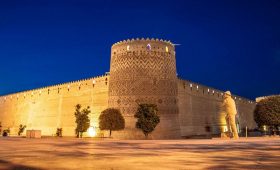The Bahman Dam: A Monument of Ancient Engineering in Fars Province, Iran
Located approximately 7 kilometers from the town of Kavar, in the Fars Province of Iran, the Bahman Dam is an ancient marvel of engineering that has stood the test of time. With origins likely dating back to the Sassanian period, this historic structure is believed to have been constructed by Bahman, the son of the legendary Esfandiyar, a figure deeply rooted in Persian mythology. The Bahman Dam is not just an important water management project; it also serves as a testament to the advanced engineering skills of ancient Persia.
Over the centuries, the dam has remained a vital part of the region’s agricultural infrastructure, and today, it is one of the most notable historical sites in Kavar, drawing attention for both its engineering and its role in local water management.
Historical Background and Significance
The Bahman Dam is thought to have been built during the Sassanian Empire, a period that is renowned for its sophisticated infrastructure projects, including irrigation systems, water management, and the construction of canals and dams. The Sassanian period, which lasted from 224 CE to 651 CE, marked an era of unparalleled engineering achievements in ancient Persia. These feats are evident in structures like the Bahman Dam, which highlights the importance of water control and distribution in sustaining agricultural life in the arid regions of Iran.
The dam is named after Bahman, a prominent figure in Persian mythology, specifically the Shahnameh (The Book of Kings) by the famous Persian poet Ferdowsi. Bahman was a heroic prince known for his strength and wisdom, and the dam that bears his name symbolizes his connection to the land and the protection of his people through the management of water resources.
The Engineering and Design of the Bahman Dam
Dimensions and Construction Materials
The Bahman Dam is an impressive feat of ancient engineering. Stretching 130 meters in length, the dam stands at a height of 9 meters at its tallest point. The dam’s structure is designed to control and divert the flow of the Qara Aghaj River, ensuring that water is directed through a series of canals to irrigate the fertile plains of the Kavar region.
One of the most remarkable aspects of the dam’s design is its construction material. The dam is made primarily from natural stones sourced from the surrounding mountainous terrain, combined with Sarooj mortar (a traditional Persian hydraulic cement). This combination of stone and mortar has proven incredibly resilient, allowing the structure to endure for nearly two millennia.
The dam’s dual construction method is noteworthy: part of the dam is built directly on the rocky bed of the river, while the other section is anchored to the side of the mountain. This unique design, blending the natural topography of the landscape with human ingenuity, has helped the structure maintain its strength and integrity over the centuries.
Water Management and Functionality
The primary function of the Bahman Dam was to divert water from the Qara Aghaj River into a canal system, which would then distribute the water to the surrounding Kavar plain. This irrigation system enabled the cultivation of crops in an area that would otherwise struggle to sustain agricultural activities due to the region’s arid climate.
The diversion of water via the canal was a significant advancement in water management, ensuring the sustainability of agriculture in Kavar. The dam not only facilitated irrigation but also protected the surrounding settlements from the dangers of unpredictable river flooding, allowing for more stable, year-round farming.
As an engineering marvel of its time, the Bahman Dam also served as a symbol of the Sassanian Empire’s power and innovation, with its construction reflecting the empire’s ability to manipulate natural resources for the benefit of its people. The Sassanian dynasty was known for its monumental projects aimed at improving agricultural yields, and the Bahman Dam stands as a testament to their commitment to harnessing the power of water for the betterment of society.
Longevity and Durability
The fact that the Bahman Dam has remained intact for over two thousand years is a remarkable testament to the quality of its construction. The use of natural stones and Sarooj mortar—materials known for their durability—has allowed the structure to endure through the harsh climatic conditions and natural forces that have affected the region over the centuries.
The dam’s placement—partly on the rocky bed of the river and partly on the mountainside—also contributes to its long-lasting durability. The mountainous foundation provides the dam with additional stability, while the stone structure remains remarkably resistant to erosion and damage from the water flow.
Today, despite some wear and tear, the Bahman Dam still stands strong and continues to serve as a remarkable historical landmark and a source of local pride. Its preservation and survival through the ages make it one of the most significant engineering monuments of the ancient world.
Tourism and Cultural Value
In recent years, the Bahman Dam has become an important cultural and historical destination in Kavar, attracting visitors interested in learning about ancient Persian engineering and the history of the Sassanian Empire. As one of the key landmarks in Fars Province, the dam is increasingly recognized for its historical value and its role in the region’s agricultural development.
Visitors to the site can observe the impressive structure up close and marvel at the architectural ingenuity of the Sassanian builders. The scenic views surrounding the dam also offer opportunities for photography and nature walks, making it a popular destination for tourists who appreciate both historical and natural beauty.
Furthermore, the dam’s location on the banks of the Qara Aghaj River provides a perfect setting for visitors to explore the natural landscape and learn about the ways in which ancient civilizations adapted to their environment. As such, the Bahman Dam serves not only as a historical monument but also as a symbol of the region’s connection to its past.
Conservation Efforts and Future Preservation
Given the historical significance of the Bahman Dam, efforts have been made to preserve and protect the site for future generations. The Iranian Cultural Heritage Organization has worked to maintain the structural integrity of the dam, conducting regular surveys and restoration projects to ensure that the ancient site does not succumb to the forces of time and nature.
While the Bahman Dam is already a national monument, ongoing conservation efforts aim to promote its inclusion in UNESCO’s World Heritage list. This would further raise awareness of the site’s cultural importance and help ensure that it remains protected from modern development pressures.
The preservation of the Bahman Dam is crucial, as it represents not only a significant piece of Persian history but also a valuable example of ancient engineering that continues to inspire architects, historians, and engineers around the world.
The Bahman Dam stands as one of the most important historical landmarks in Fars Province, Iran. With its remarkable construction, its role in ancient Persian irrigation systems, and its enduring durability, the dam is a symbol of the ingenuity and engineering excellence of the Sassanian Empire.
From its origins in the Sassanian era to its modern-day role as a significant tourist attraction, the Bahman Dam continues to offer insights into ancient Persian water management, architecture, and cultural heritage. As one of the most enduring symbols of Persian ingenuity, the dam remains an essential part of the region’s history and will continue to captivate visitors and scholars for years to come.

